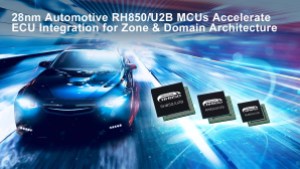The latest automotive processors developed over the last quarter are tackling big challenges in the evolving automotive industry. These include addressing demand for advanced safety features, including advanced driver-assistance systems (ADAS) and autonomous driving, advanced in-vehicle systems along with artificial-intelligence deployment, and functional safety requirements. This includes Automotive Safety Integrity Levels (ASIL) defined by ISO 26262.
These automotive processors also need to handle evolving electrical/electronic (E/E) architectures and new communications interfaces as well as increased security for intelligent, connected vehicles. Ultimately, this means developing processors that enable new advanced automotive systems that are easy to implement at the right cost and on time.
Here are a few examples of microcontrollers (MCUs) and vehicle network processors announced over the past quarter. Many of them are sampling now and will be available over the next two years.
Infineon Technologies AG recently extended its AURIX microcontroller family with the launch — and first samples — of its AURIX TC4x family of 28-nm MCUs for next-generation eMobility, ADAS, automotive E/E architectures, and AI applications. The new family provides a migration path for the company’s AURIX TC3x MCU family.

Infineon’s AURIX TC4x MCUs target next-generation eMobility, ADAS, automotive E/E architectures, and AI applications. (Source: Infineon Technologies AG)
The AURIX TC4x MCUs feature the next-generation TriCore 1.8 and scalable performance enhancements from the AURIX accelerator suite. This includes the new parallel processing unit (PPU) and a SIMD vector digital signal processor that addresses requirements for a variety of AI topologies. Use cases can be as diverse as real-time control and radar post-processing, said Infineon.
Targeting a range of automotive applications including the demand for functional integration in domain and zone-based E/E architectures, the AURIX TC4x supports both eMobility and automated driving through safety systems. The devices meet safety levels up to ASIL-D, and new cybersecurity modules meet the new ISO 21434 standard.
The AURIX TC4x MCUs also provide new software-over-the-air features that help meet demand for secure car-to-cloud connection, enabling updates in the field, as well as diagnosis and analysis during vehicle usage. The MCU family supports high-speed communication interfaces like 5-Gbit Ethernet and PCI Express along with new interfaces such as CAN-XL and 10BASE T1S Ethernet.
Infineon is also collaborating with Synopsys to fast-track software development for the AURIX TC4x family. The Synopsys Virtualizer Development Kit for TC4x is said to enable software to be developed much earlier in the design cycle. The Synopsys DesignWare ARC MetaWare Toolkit for AURIX TC4x provides compilers, debuggers, and libraries as well as a simulator needed to develop software for the PPU. In addition, MATLAB support will be available for auto-code generation to enable rapid prototyping.
The AURIX TC49x is sampling now at selected customers. Production is scheduled for the second half of 2024. The DesignWare ARC MetaWare Toolkit for AURIX and Virtualizer Development Kit for TC4x are available now from Synopsys.
With safety as a primary concern in automotive applications, Microchip Technology Inc. recently added certified ISO 26262 functional safety packages for its PIC17 and AVR MCUs as well as for the dsPIC33C digital signal controllers (DSCs) to help drive the development of safety-critical designs targeting ASIL-B and ASIL-C safety level and certification efforts.

Microchip offers ISO 26262 functional safety packages for its PIC17 and AVR MCUs and dsPIC33C DSCs. (Source: Microchip Technology Inc.)
The complete functional safety ecosystem for PIC18 and AVR MCUs includes AEC Q100 Grade 1–qualified functional-safety–ready PIC18-Q84 MCUs with CAN FD and AVR DA MCUs with LIN interfaces. Both come with hardware support for capacitive-touch sensors. They also include SGS TÜV Saar-certified ASIL-B–ready failure modes, effects, and diagnostic analysis (FMEDA) report and functional safety manual (FSM) as well as functional safety diagnostic libraries. This includes ASIL-B–ready certificates and certification reports.
The complete functional safety ecosystem for dsPIC33C DSCs includes AEC Q100 Grade 0–qualified functional-safety–ready dsPIC33C DSCs with dedicated hardware safety features and SGS TÜV Saar-certified ASIL-B–ready FMEDA report and FSM. It also provides TÜV Rheinland–certified functional safety diagnostic libraries for designs targeting up to ASIL-C; a functional safety reference application, which includes the steps required to develop compliant designs; and the collateral that must be generated for (ASIL-B or ASIL-C) compliance, as well as a variety of functional safety analysis reports and certification reports.
Microchip offers three ISO 26262 functional safety packages for customers with different levels of expertise and in different stages of their evaluation and design cycles. These include basic, starter, and full packages:
- The functional safety basic package offers basic resources like the ASIL-B–ready certified FMEDA and safety manual to get started with the evaluation of target functional safety levels and the design of safety-critical automotive applications.
- The functional safety starter package offers ASIL-B–ready certified FMEDA and safety manual, a reference application, and ASIL-C–compliant diagnostic libraries that help designers understand the ISO 26262–compliant development process and the reports that must be generated for compliance.
- The functional safety full package offers a complete solution for beginners and experienced experts to simplify the design and certification of safety-critical automotive applications. In addition to the offerings of the starter package, the full package includes certified diagnostic libraries with source code and the associated safety-analysis reports for designs targeting up to ASIL-C.
Microchip also provides a TÜV SÜD–certified design tool package for its MPLAB development tools ecosystem. This includes a MPLAB XC functional safety compiler as well as a functional safety manual, safety plans, tools classification, and qualification reports for the compiler.
The company also offers functional-safety–ready CAN FD and LIN transceivers and other companion devices, including voltage supervisor devices, which can be used with the functional-safety–ready MCUs and DSCs in a range of automotive applications.
The ISO 26262 functional-safety–ready dsPIC33C DSCs and PIC18 and AVR MCUs are supported by the TÜV SÜD–certified MPLAB XC16 and MPLAB XC8 functional safety compilers (SW006022-FS and SW006021-FS), the MPLAB Code Coverage tool (SW006026-COV), MPLAB X IDE, MPLAB development ecosystem debugger/programmers and the safety documentation package to make the tool qualification effort easier.
For software-defined–vehicle applications, NXP Semiconductors has extended its S32G vehicle network processor family with the introduction of the S32G3 Series with four initial devices. Software- and pin-compatible with the S32G2 Series launched into full production in the second quarter of 2021, these new devices offer up to 2.5× more application processing performance, on-chip system memory, and networking than the current highest-performance S32G2 Series device to enable more electronic control unit (ECU) consolidation and to support intelligent software-defined vehicles.
NXP said the evolution of ECU consolidation and vehicle architecture to domain and zonal architectures require the integration of more processing, memory, networking bandwidth, and resource isolation. “These intelligent connected vehicles demand more advanced ADAS safety and secure real-time and application processing to offer new vehicle and data-driven cloud services that support smart mobility and smart cities,” said the company.
The new series also provides Ethernet bandwidth on two ports and doubles the number of isolation domains, which are critical for future ECU consolidation, said NXP.
In addition, the performance enhancements with the same package pinout meet the needs of more demanding software-defined vehicles, said NXP. The EVB3 evaluation board, RDB3 reference design, and GoldBox 3 rugged enclosure version, combined with software and the Vehicle Integration Platform (GoldVIP) for connected gateway development, provide platform solutions.
NXP also offers companion products, including the SJA1110 multi-gigabit automotive Ethernet switch with integrated 100BASE-T1 PHYs, hardware-assisted security and safety capabilities, and multi-gigabit interfaces. NXP also developed the PF53 as a companion chip of the VR5510, which is a high-performance 12-A core supply regulator with adaptive voltage positioning, along with a variety of in-vehicle network transceivers.
The initial S32G399A device is sampling to lead customers. Production launch is expected in the first quarter of 2023.
Also targeting changes in ECU integration are the RH850/U2B MCUs from Renesas Electronics Corporation. These MCUs address the growing need to integrate multiple applications into a single chip and realize a unified ECU for the evolving E/E architecture, said the company.
The cross-domain RH850/U2B MCUs are built for the workloads required by vehicle motion in terms of hybrid ICE and xEV traction inverter, high-end zone control, connected gateway, and domain-control applications.

Renesas’s 28-nm RH850/U2B MCUs target domain- and zone-based E/E architectures. (Source: Renesas Electronics Corp.)
The expansion covers devices that range from RH850/U2A MCUs for body and chassis control systems up to high-performance RH850/U2B MCUs. Renesas said that customers can combine these MCUs with the company’s R-Car S4 system-on-chip devices for automotive central gateway systems to build a scalable solution for E/E architectures.
Designed for zone and domain applications, the 28-nm RH850/U2B MCUs build on the functionality of Renesas’s RH850/E2x Series for powertrain and RH850/C1M-Ax Series for HEV/EV motor control while adding several enhancements, including new accelerator IP, higher performance levels, and increased security. This enables users to integrate multiple ECU functions into a single ECU while still meeting automotive-grade safety, security, and real-time operation requirements, said Renesas.
The MCU’s integrated hypervisor hardware-based virtualization assist function allows multiple software systems with up to ISO 26262 ASIL-D functional safety levels to operate independently, and the quality of service provides a latency monitor and regulation function for all bus masters to ensure minimum bandwidth is always available.
The RH850/U2B MCUs also support no-wait OTA software updates with dual-bank embedded flash that allows the ECU to update and save images while the MCUs are in active mode and enables the ECU to operate from the original code if a failure occurs.
The MCUs also feature up to eight 400-MHz performance cores, up to 32-MB flash, a new high-performance motor-control accelerator IP (EMU3S) that works in conjunction with multiple dedicated motor-control timer structures like GTM v4.1 and TSG3, and a dedicated data flow processor accelerator IP that enables the CPU to offload compute-heavy operations for complex control.
Other features include integrated security functions that support the Evita Full standard, including elliptic-curve cryptography for enhanced protection against cyberattacks and a dedicated resolver/digital converter accelerator IP (RDC3X) that processes analog signals from a motor rotational angle sensor (resolver) or an inductive position sensor. It also includes multiple instances of AES128 lock-step modules for conflict-free, deterministic safe and secure communication, and several communication interfaces, including Gigabit Ethernet TSN with switch support, CAN-FD, SPI, RHSB (MSC), RHSIF, SENT, LIN, UART, I2C, and PSI5.
Samples of the RH850/U2B MCU will be available starting in April 2022. An extensive ecosystem supporting the latest standards are available.
Advertisement
Learn more about Infineon TechnologiesMicrochip TechnologyNXP SemiconductorsRenesas Electronics America





